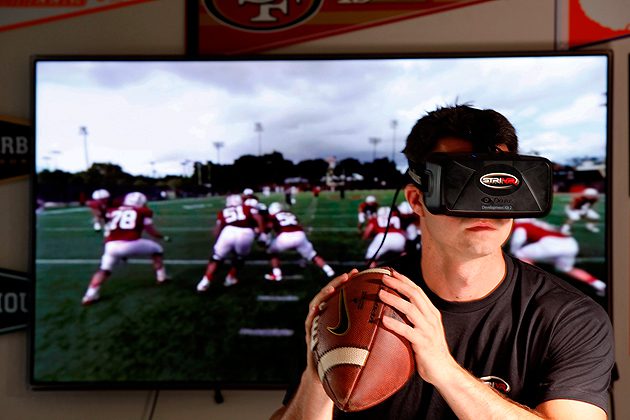Virtual Reality , or “VR” for short, is a technology that involves wearing a special headset, usually including earphones and a visor, to immerse the user in a digital world. Augmented Reality, often abbreviated as “AR”, works similarly, but often uses images from the surrounding world overlaid with computer-generated features. The visual differences are kind of like a stained glass window versus a regular window that has images drawn on it with a marker.
Most of the work in these fields has been done by the videogame industry, and indeed gamers look forward to these technologies making their favorite games feel more immersive. These technologies are also being used in education but their attempts to create new worlds make some wonder if they could one day help athletes perform better, and help average people to stay fit.
As the technology stands today Virtual Reality is most closely related to fitness in terms of understanding and education. There are several applications relating to anatomy and physiology that can help users to understand information on health and the human body in new and more interactive ways through tools like 3D visualization of medical models.
Some athletes, like runners, also find it useful to watch footage of themselves running, swimming, or hitting a ball in VR displays to help them see up close and from multiple perspectives how they can change their technique to make them faster or reduce wear much easier than they could get this information from a coach. Stanford, one of the seven universities and colleges using VR and AR in their athletics programs, believes that this method of training may have helped their quarterback complete up to 76% more passes in a season. Bruce Arians, head coach for the Arizona Cardinals commented “Twenty-five Years ago, I was looking for something like this”. Unfortunately, because most VR headsets currently need to be plugged into a console and always prevent the user from visualizing their actual surroundings, there are few applications for exercising the physical body while in the virtual environment.
Augmented Reality, however, while not as interesting to some, has much more potential for use in active exercise. Because AR technology uses visual input from the user’s actual surroundings, it is much easier and safer for users to be active while wearing an AR device without worrying about running into things. Furthermore, many AR applications are currently used on mobile devices with a head-mount, meaning that they don’t need to be plugged in, which also allows for greater freedom of movement free from chords to trip over or come unplugged from a bulky console.
Right now most of the work being done in the development of AR technology for active use is being done by college and professional football teams who are experimenting with overlaying play options for athletes to follow on the field. Some high-end VR projects are also being used by professional and semi professional athletes in the hope if simulating a field full of people such as an opposing team. Iowa State University, for example, has the most advanced VR system in the world that its football team uses for recruitment, but it also has a smaller more conventional program for head-mounted VR systems. Should this technology be made available to the public in the future it would make it significantly easier for individuals to practice group sports without putting a team together, or practice sports when the weather is poor without needing to use a full-size court.
These applications are still very far from being available to the general public, largely due to the cost of such technologies. That having been said, it is likely that simpler applications for more general use will be developed to help ordinary people do things like track steps, distance, or burned calories as AR technology becomes more common and less expensive. In the last three years alone the price of the average VR headset has dropped thousands of dollars, and is now only slightly more expensive than the average gaming console. Most AR headsets can be purchased for less than fifty dollars.
At the moment VR and AR technologies have very limited applications when it comes to improving physical fitness. Both of these fields, however, are huge and rapidly growing industries and the focus of constant research, and more varied applications for VR and AR in wellness are likely just around the corner.













Comments are closed.